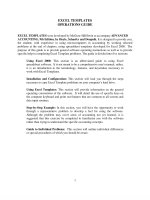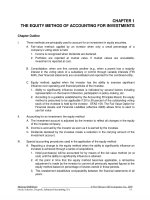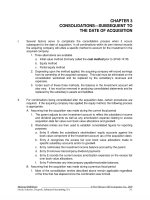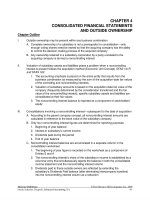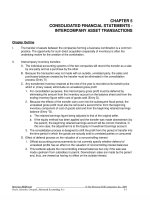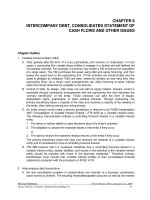Solution manual advanced accounting 9e by hoyle ch05
Bạn đang xem bản rút gọn của tài liệu. Xem và tải ngay bản đầy đủ của tài liệu tại đây (869.41 KB, 58 trang )
Find more slides, ebooks, solution manual and testbank on www.downloadslide.com
CHAPTER 5
CONSOLIDATED FINANCIAL STATEMENTS INTERCOMPANY ASSET TRANSACTIONS
Chapter Outline
I.
The transfer of assets between the companies forming a business combination is a common
practice. The opportunity for such direct acquisition (especially of inventory) is often the
underlying motive for the creation of the combination.
II.
Intercompany inventory transfers
A. The individual accounting systems of the two companies will record the transfer as a sale
by one party and as a purchase by the other
B. Because the transaction was not made with an outside, unrelated party, the sales and
purchases balances created by the transfer must be eliminated in the consolidation
process (Entry Tl)
C. Any transferred inventory retained at the end of the year is recorded at its transfer price
which in (many cases) will include an unrealized gross profit
1. For consolidation purposes, this intercompany gross profit must be deferred by
eliminating the amount from the inventory account on the balance sheet and from the
ending inventory figure within cost of goods sold (Entry G).
2. Because the effects of the transfer carry over into the subsequent fiscal period, the
unrealized gross profit must also be removed a second time: from the beginning
inventory component of cost of goods sold and from the beginning retained earnings
balance (Entry *G).
a. The retained earnings figure being adjusted is that of the original seller.
b. If the equity method has been applied and the transfer was made downstream (by
the parent), the beginning retained earnings account will be correct; therefore, in
this one case, the adjustment is to the Equity in Investment Earnings account.
3. The consolidation process is designed to shift the profit from the period of transfer into
the time period in which the goods are actually sold to unrelated parties or consumed
D. Effect of deferral process on the valuation of a noncontrolling interest
1. Official accounting pronouncements do not currently specify whether deferral of
unrealized profits has an effect on the valuation of noncontrolling interest balances
2. This textbook adjusts the noncontrolling interest balances but only if the sale was
made upstream from subsidiary to parent. Downstream sales are made by the parent
and, thus, are viewed as having no effect on the outside interest.
McGraw-Hill/Irwin
Hoyle, Schaefer, Doupnik, Advanced Accounting, 9/e
© The McGraw-Hill Companies, Inc., 2009
5-1
Find more slides, ebooks, solution manual and testbank on www.downloadslide.com
III.
Intercompany land transfers
A. Any gain created by intercompany land transfers is unrealized and will remain so until the
land is sold to an outside party
B. For each subsequent consolidation, the recorded value of the land account must be
reduced to original cost with the unrealized gain that was recorded by the seller also
being eliminated
1. In the year of transfer, an actual gain account exists within the accounting records of
the seller and must be removed.
2. In all later time periods, since the unrealized gain has become an element of the
seller's beginning retained earnings balance, the reduction is made to this equity
account.
3. If the land is ever sold to an outside party, the intercompany gain is realized and has
to be recognized within that time period.
IV.
Intercompany transfer of depreciable assets
A. As with other intercompany transfers, any unrealized gross profit must be deferred for
consolidation purposes to establish appropriate historical cost balances.
B. However, the difference between the transfer-based accounting value and the historical
cost of the asset will change each year because of the effects of depreciation. The
amount of unrealized gain within retained earnings will also be reduced annually since
excess depreciation expense is recognized (and closed into retained earnings) based on
the inflated transfer price.
C. Consequently, elimination of the unrealized gain (within retained earnings) and the
reduction of the asset value to historical cost will differ from year to year.
D. Also within the consolidation process, the recorded depreciation expense must be
decreased every period to an amount appropriately based on the asset's original
acquisition price.
Learning Objectives
1.
Understand that intercompany asset transfers often create accounting effects within the
financial records of the individual companies that must be eliminated or adjusted prior to
production of consolidated financial statements.
2.
Eliminate the sales and purchases balances that are created by the intercompany transfer of
inventory (Entry Tl).
3.
Compute the amount of unrealized gross profit included in the recorded value of any
transferred inventory that is still being held by the buyer at the end of a fiscal period.
4.
Prepare the consolidation entry (Entry G) to eliminate any intercompany inventory gross profit
that remains unrealized at the end of the year of transfer.
McGraw-Hill/Irwin
5-2
© The McGraw-Hill Companies, Inc., 2009
Solutions Manual
Find more slides, ebooks, solution manual and testbank on www.downloadslide.com
5.
Understand that the consolidation process for inventory transfers is designed to defer the
unrealized portion of an intercompany gross profit from the year of transfer into the year of
disposal or consumption.
6.
Make the consolidation entry (Entry *G) to eliminate unrealized intercompany gross profits from
beginning retained earnings (or in one specific instance from the Equity in Subsidiary Earnings
account) and from the cost of goods sold for the period following the year of transfer.
7.
Understand the difference in upstream and downstream transfers and how each affects the
computation of noncontrolling interest balances.
8.
Eliminate any unrealized gain created by the intercompany transfer of land from the
accounting records of the year of transfer and subsequent years.
9.
Understand that the elimination process for unrealized gross profits created by intercompany
land transfers must be repeated in each fiscal period for as long as the asset is held within the
business combination.
10.
Realize that the account balances created by an unrealized gain resulting from the
intercompany transfer of a depreciable asset will change from period to period because of the
effect of depreciation expense.
11.
Compute and eliminate the unrealized gain created by intercompany transfers of depreciable
assets for any date subsequent to the transaction.
12.
Produce the worksheet entry to reduce depreciation expense from a figure based on transfer
price to one calculated from the asset's historical cost balance.
Answers to Discussion Questions
Earnings Management
By selling goods to special purpose entities that it controlled but did not consolidate, did Enron
overstate its earnings?
According to the Power’s Report (Report of Investigation by the Special Investigative Committee of
the Board of Directors of Enron Corp.—February 1, 2004)
These partnerships—Chewco, LJM1, and LJM2—were used by Enron
Management to enter into transactions that it could not, or would not, do with
unrelated commercial entities. Many of the most significant transactions apparently
were designed to accomplish favorable financial statement results,
not to achieve bona fide economic objectives or to transfer risk. (page 4)
Assuming Enron controlled LJM2, the transactions that produced the $67 million gain and the $20.3
million agency fee were not arm’s length and thus did not provide a proper basis for recognizing
income.
What effect does consolidation have on the financial reporting for transactions with controlled
entities?
In consolidation, all intercompany profit would have been deferred until the goods were sold to an
outside party. Also the intercompany note receivable and payable would have been eliminated in
consolidation.
As noted by Bala Dahran in his February 6, Congressional Testimony
McGraw-Hill/Irwin
Hoyle, Schaefer, Doupnik, Advanced Accounting, 9/e
© The McGraw-Hill Companies, Inc., 2009
5-3
Find more slides, ebooks, solution manual and testbank on www.downloadslide.com
Despite their potential for economic and business benefits, the use of SPEs has
always raised the question of whether the sponsoring company has some other
accounting motivations, such as hiding of debt, hiding of poor-performing assets, or
earnings management. Additionally, explosive growth in the use of SPEs led to
debates among managers, auditors and accounting standard setters as to whether
and when SPEs should be consolidated. This is because the intended accounting
effects of SPEs can only be achieved if the SPEs are reported as unconsolidated
entities separate from the sponsoring entity.
FASB Activity on Special Purpose Entities
Fortunately the FASB’s Interpretation 46R Consolidation of Variable Interest Entities explains how to
identify an SPE that is not subject to control through voting ownership interests, but is nonetheless
controlled by another enterprise and therefore subject to consolidation. The FASB requires each
enterprise involved with an SPE to determine whether the financial support provided by that
enterprise makes it the primary beneficiary of the SPE’s activities. The primary beneficiary of the
SPE would then be required to include the assets, liabilities, and results of the activities of the SPE in
its consolidated financial statements.
What Price Should We Charge Ourselves?
Transfer pricing is actually a topic for a managerial accounting discussion. Students, though, need to
be aware that managerial and financial accounting do overlap at times. In this illustration, the price
set by company officials for this component will affect the specific consolidation procedures needed
in the preparation of financial statements for external reporting purposes.
Since Slagle owns 100 percent of Harrison's common stock, consolidated net income will not be
altered by the transfer pricing decision. All intercompany transactions as well as unrealized profits will
be eliminated entirely. However, because the sales are upstream, if a noncontrolling interest had
been present, the portion of the subsidiary's income attributed to these outside owners would be
influenced by the markup. Both the noncontrolling interest figure on the balance sheet and on the
income statement are impacted by the amount of profits that remain unrealized when transactions
are from subsidiary to parent.
To the accountant, the easiest approach is to set the transfer price at the seller's cost ($70.00 in this
case). No intercompany profits are created and the consolidation process is less complicated.
However, as indicated in the narrative, that price may penalize the seller since no profits are
recognized by that profit center. In addition, the buyer will then show artificially inflated income. Thus,
some amount of profit is usually built into transfer pricing decisions. Those students who have
already completed cost/managerial accounting can be asked to describe the various factors that
should influence the establishment of this price. Interaction between accounting courses is beneficial
to the students.
McGraw-Hill/Irwin
5-4
© The McGraw-Hill Companies, Inc., 2009
Solutions Manual
Find more slides, ebooks, solution manual and testbank on www.downloadslide.com
Answers to Questions
1.
2.
3.
4.
5.
6.
One reason for the significant volume and frequency of intercompany transfers is that many
business combinations are specifically organized so that the companies can provide
products for each other. This design is intended to benefit the business combination as a
whole because of the economies provided by vertical integration. In effect, more profit can
often be generated by the combination if one member is able to buy from another rather than
from an outside party.
The sales between Barker and Walden totaled $100,000. Regardless of the ownership
percentage or the markup, the $100,000 was simply an intercompany asset transfer. Thus,
within the consolidation process, the entire $100,000 should be eliminated from both the
Sales and the Purchases (Inventory) accounts.
Sales price per unit ($900,000 ÷ 3,000 units)
$ 300
Number of units in Safeco’s ending inventory
× 500
Intercompany inventory at transfer price
$150,000
Gross profit rate (.6 ÷ 1.6)
.375
Intercompany profit in ending inventory
$56,250
In intercompany transactions, a transfer price is often established that exceeds the cost of
the inventory. Hence, the seller is recording a gross profit on its books that, from the
perspective of the business combination as a whole, remains unrealized until the asset is
consumed or sold to an outside party. Any unrealized gross profit on merchandise still held
by the buyer must be eliminated whenever consolidated financial statements are produced.
For the year of transfer, this consolidation procedure is carried out by removing the
unrealized gross profit from the inventory account on the balance sheet and from the ending
inventory balance within cost of goods sold. In the year following the transfer (if the goods are
resold or consumed), the unrealized gross profit must again be eliminated within the
consolidation process. This second reduction is made on the worksheet to the beginning
inventory component of cost of goods sold as well as to the beginning retained earnings
balance of the original seller. The gross profit is then moved into the year of realization. If the
transfer was downstream in direction and the parent company has applied the equity
method, the adjustment in the subsequent year must be made to the equity in subsidiary
earnings account rather than to retained earnings.
On the individual financial records of James, Inc., a gross profit is recorded in the year of
transfer. From the viewpoint of the business combination, this gross profit is actually earned
in the period in which the products are sold or consumed by Matthews Co. An initial
consolidation entry must be made in the year of transfer to defer any gross profit that remains
unrealized. A second entry must be made in the following time period to allow the gross profit
to be recognized in the year of its ultimate realization.
Currently, no official accounting pronouncement answers the question as to the relationship
between unrealized intercompany profits and noncontrolling interest values, although the
issue has been under study by the FASB. This textbook reasons that unrealized profits relate
to the seller and to the computation of the seller's income. Therefore, any unrealized profits
created by upstream transfers (from subsidiary to parent) are attributed to the subsidiary. The
effects resulting from the deferral and eventual recognition of these intercompany profits are
considered to have an impact on the calculation of noncontrolling interest balances. In
contrast, unrealized profits from downstream transfers are viewed as relating solely to the
parent (as the seller) and, thus, have no effect on the noncontrolling interest.
McGraw-Hill/Irwin
Hoyle, Schaefer, Doupnik, Advanced Accounting, 9/e
© The McGraw-Hill Companies, Inc., 2009
5-5
Find more slides, ebooks, solution manual and testbank on www.downloadslide.com
7.
8.
9.
10.
11.
The basic consolidation process does not differ between downstream and upstream
transfers. Sales and purchases (Inventory) balances created by the transactions must be
eliminated in total. Any unrealized gross profits remaining at the end of a fiscal period are
deferred until ultimately earned through sale or consumption of the assets.
The direction of intercompany transfers (upstream versus downstream) does have one effect
on consolidated financial statements. In computing noncontrolling interest balances (if
present), the deferral of unrealized gross profits on upstream sales is taken into account.
Downstream sales, however, are attributed to the parent and are viewed as having no impact
on the outside interest.
The computation of this noncontrolling interest balance is dependent on the direction of the
intercompany transactions that is not indicated in this question. If the unrealized gross profits
were created by downstream sales from King to Pawn, they relate only to King. The
noncontrolling interest in the subsidiary's net income is not affected and would be $11,000
($110,000 × 10%). In contrast, if the transfers were upstream from Pawn to King, the deferral
and recognition of the profits are attributed to Pawn. Pawn's "realized" income would be
$80,000 and the noncontrolling interest's share of the subsidiary's income is reported as
$8,000:
Pawn's reported income .................................................
$110,000
Recognition of prior year unrealized gross profit ...........
30,000
Deferral of current year unrealized gross profit .............
(60,000)
Pawn's realized income ..................................................
$80,000
Outside ownership percentage ......................................
10%
Noncontrolling interest in subsidiary's income ................
$ 8,000
The deferral and subsequent recognition of intercompany profits are allocated to the
noncontrolling interest in the same periods as the parent. When one affiliate sells to another
affiliate, ownership does not change and therefore the underlying profit is deferred. When
the purchasing affiliate subsequently sells the inventory to an entity outside the affiliated
group, ownership changes, and the profit may be recognized. Intercompany profits are not
really eliminated, but simply deferred until a sale to an outsider takes place.
Several differences can be cited that exist between the consolidated process applicable to
inventory transfers and that which is appropriate for land transfers. The total intercompany
Sales balance is offset against Purchases (Inventory) when inventory is transferred but no
corresponding entry is needed when land is involved. Furthermore, in the year of the sale,
ending unrealized inventory gross profits are eliminated through an adjustment to cost of
goods sold but a specific gross profit account exists (and must be removed) when land has
been sold. Finally, unrealized inventory gross profits are usually expected to be realized in
the year following the transfer. This effect is mirrored in that period by reduction of the
beginning inventory figure (within cost of goods sold). For land transfers, however, the
unrealized gain must be repeatedly deferred in each fiscal period for as long as the land
continues to be held within the business combination.
As long as the land is held by the parent, its recorded value must be reduced to historical
cost within each consolidated set of financial statements. In the year of the original transfer,
the asset reduction is offset against the subsidiary's recorded gain. For all subsequent years
in which the property is held, the credit to the Land account is made against the beginning
retained earnings balance of the subsidiary (since the unrealized gain will have been closed
into that account).
McGraw-Hill/Irwin
5-6
© The McGraw-Hill Companies, Inc., 2009
Solutions Manual
Find more slides, ebooks, solution manual and testbank on www.downloadslide.com
12.
13.
According to this question, the land is eventually sold to an outside party. The intercompany
gain (which has been deferred in each of the previous years) is realized by the sale and
should be recognized in the consolidated statements of this later period.
Because the transfer was upstream from subsidiary to parent, the above consolidated
entries will also affect any noncontrolling interest balances being reported. Because of the
deferral of the intercompany gross profit, the realized income balances applicable to the
subsidiary will be less than the reported values. In the year of resale, however, the realized
income for consolidation purposes is higher than reported. All noncontrolling interest totals
are computed on the realized balances rather than the reported figures.
Depreciable assets are often transferred between the members of a business combination at
amounts in excess of book value. The buyer will then compute depreciation expense based
on this inflated transfer price rather than on an historical cost basis. From the perspective of
the business combination, depreciation should be calculated solely on historical cost figures.
Thus, within the consolidation process for each period, adjustment of the depreciation (that is
recorded by the buyer) is necessary to reduce the expense to a cost-based figure.
From the viewpoint of the business combination, an unrealized gain has been created by the
intercompany transfer and must be eliminated whenever consolidated financial statements
are produced. This unrealized gain is closed by the seller into retained earnings necessitating
subsequent reductions to that account. In the individual financial records, however, another
income effect is created which gradually reduces the overstatement of retained earnings
each period. The asset will be depreciated by the buyer based on the inflated transfer price.
The resulting expense will be higher than the amount appropriate to the historical cost of the
item. Because this excess depreciation is closed into retained earnings annually, the
overstatement of the equity account is gradually reduced to a zero balance over the life of
the asset.
McGraw-Hill/Irwin
Hoyle, Schaefer, Doupnik, Advanced Accounting, 9/e
© The McGraw-Hill Companies, Inc., 2009
5-7
Find more slides, ebooks, solution manual and testbank on www.downloadslide.com
Answers to Problems
1. C
2. B Inventory remaining $100,000 × 50% = $50,000 Unrealized gross profit (based
on Lee's markup as the seller) $50,000 × 40% = $20,000. The ownership
percentage has no impact on this computation.
3. A
4. C UNREALIZED GROSS PROFIT, 12/31/09
Intercompany Gross profit ($100,000 – $75,000) ..........................
Inventory Remaining at Year's End ..............................................
Unrealized Intercompany Gross profit, 12/31/09 ..........................
$25,000
16%
$4,000
UNREALIZED GROSS PROFIT, 12/31/10
Intercompany Gross profit ($120,000 – $96,000) ..........................
Inventory Remaining at Year's End ..............................................
Unrealized Intercompany Gross profit, 12/31/10 ..........................
$24,000
35%
$8,400
CONSOLIDATED COST OF GOODS SOLD
Parent balance ..........................................................................
Subsidiary Balance ...................................................................
Remove Intercompany Transfer ..............................................
Recognize 2009 Deferred Gross profit ....................................
Defer 2010 Unrealized Gross profit .........................................
Cost of Goods Sold .......................................................................
$380,000
210,000
(120,000)
(4,000)
8,400
$474,400
5. A Intercompany sales and purchases of $100,000 must be eliminated.
Additionally, an unrealized gross profit of $10,000 must be removed from
ending inventory based on a markup of 25 percent ($200,000 gross
profit/$800,000 sales) which is multiplied by the $40,000 ending balance. This
deferral increases cost of goods sold because ending inventory is a negative
component of that computation. Thus, cost of goods sold for consolidation
purposes is $690,000 ($600,000 + $180,000 – $100,000 + $10,000).
6. C The only change here from Problem 5 is the markup percentage which would
now be 40 percent ($120,000 gross profit $300,000 sales). Thus, the
unrealized gross profit to be deferred is $16,000 ($40,000 × 40%). Consequently,
consolidated cost of goods sold is $696,000 ($600,000 + $180,000 – $100,000 +
$16,000).
McGraw-Hill/Irwin
5-8
© The McGraw-Hill Companies, Inc., 2009
Solutions Manual
Find more slides, ebooks, solution manual and testbank on www.downloadslide.com
7. B UNREALIZED GROSS PROFIT, 12/31/09
Ending inventory ......................................................................
Markup ($33,000/$110,000) .......................................................
Unrealized intercompany gross profit, 12/31/09 .....................
$40,000
30%
$12,000
UNREALIZED GROSS PROFIT, 12/31/10
Ending inventory ......................................................................
Markup ($48,000/$120,000) .......................................................
Unrealized intercompany gross profit, 12/31/10 .....................
$50,000
40%
$20,000
NONCONTROLLING INTEREST IN SUBSIDIARY'S INCOME
Reported income for 2010 ........................................................
Realized gross profit deferred in 2009 ....................................
Deferral of 2010 unrealized gross profit ..................................
Realized income of subsidiary ................................................
Outside ownership ...................................................................
Noncontrolling interest ............................................................
$90,000
12,000
(20,000)
$82,000
10%
$8,200
8. A Individual Records after Transfer
12/31/09
Machinery—$40,000
Gain—$10,000
Depreciation expense $8,000 ($40,000/5 years)
Income effect net—$2,000 ($10,000 – $8,000)
12/31/10
Depreciation expense—$8,000
Consolidated Figures—Historical Cost
12/31/09
Machinery—$30,000
Depreciation expense—$6,000 ($30,000/5 years)
12/31/10
Depreciation expense--$6,000
Adjustments for Consolidation Purposes:
2009: $2,000 income is reduced to a $6,000 expense (income is reduced
by $8,000)
2010: $8,000 expense is reduced to a $6,000 expense (income is increased
by $2,000)
McGraw-Hill/Irwin
Hoyle, Schaefer, Doupnik, Advanced Accounting, 9/e
© The McGraw-Hill Companies, Inc., 2009
5-9
Find more slides, ebooks, solution manual and testbank on www.downloadslide.com
9. B UNREALIZED GAIN
Transfer Price ...........................................................................
Book Value (cost after two years of depreciation) .................
Unrealized Gain ........................................................................
$280,000
240,000
$40,000
EXCESS DEPRECIATION
Annual Depreciation Based on Cost ($300,000/10 years) .......
Annual Depreciation Based on Transfer Price
($280,000/8 years) ................................................................
Excess Depreciation .................................................................
$30,000
35,000
$5,000
ADJUSTMENTS TO CONSOLIDATED NET INCOME
Defer Unrealized Gain ..............................................................
Remove Excess Depreciation ..................................................
Decrease to Consolidated Net Income ....................................
$(40,000)
5,000
$(35,000)
10. D Add the two book values and remove $100,000 intercompany transfers.
11. C Intercompany gross profit ($100,000 - $80,000) ...........................
Inventory remaining at year's end ................................................
Unrealized intercompany gross profit ..........................................
$20,000
60%
$12,000
CONSOLIDATED COST OF GOODS SOLD
Parent balance ..........................................................................
Subsidiary balance ...................................................................
Remove intercompany transfer ...............................................
Defer unrealized gross profit (above) .....................................
Cost of goods sold ........................................................................
$140,000
80,000
(100,000)
12,000
$132,000
12. C Consideration transferred ............................
Noncontrolling interest fair value ..................
Suarez total fair value .....................................
Book value of net assets ................................
Excess fair over book value
$260,000
65,000
$325,000
(250,000)
$75,000
Life
Annual Excess
Amortizations
Excess fair value assigned to undervalued assets:
Equipment ..................................................
25,000 5 years
Secret Formulas .......................................
$50,000 20 years
Total ...............................................................
-0-
$5,000
2,500
$7,500
Consolidated Expenses = $37,500 (add the two book values and include
current year amortization expense)
McGraw-Hill/Irwin
5-10
© The McGraw-Hill Companies, Inc., 2009
Solutions Manual
Find more slides, ebooks, solution manual and testbank on www.downloadslide.com
13. A 20% of the beginning book value
Excess fair value allocation (20%× $75,000)
20% share of Suarez net income
adjusted for amortization (20% × [110,000 – 7,500])
Ending noncontrolling interest balance
$50,000
15,000
20,500
$85,500
14. C Add the two book values plus the original allocation ($25,000) less one year of
excess amortization expense ($5,000).
15. B Add the two book values less the ending unrealized gross profit of $12,000.
Intercompany Gross profit ($100,000 – $80,000) ..........................
Inventory Remaining at Year's End ..............................................
Unrealized Intercompany Gross profit, 12/31 ..............................
16.
$20,000
60%
$12,000
(15 Minutes) (Determine selected consolidated balances; includes inventory
transfers and an outside ownership.)
Customer list amortization = $65,000/5 years = $13,000 per year
Intercompany Gross profit ($160,000 – $120,000) ........................
Inventory Remaining at Year's End ...............................................
Unrealized Intercompany Gross profit, 12/31 ..............................
$40,000
20%
$8,000
CONSOLIDATED TOTALS
Inventory = $592,000 (add the two book values and subtract the ending
unrealized gross profit of $8,000)
Sales = $1,240,000 (add the two book values and subtract the $160,000
intercompany transfer)
Cost of Goods Sold = $548,000 (add the two book values and subtract the
intercompany transfer and add [to defer] ending unrealized gross profit)
Operating Expenses = $443,000 (add the two book values and the
amortization expense for the period)
Noncontrolling Interest in Subsidiary's Net Income = $8,700 (30 percent of
the reported income after subtracting 13,000 excess fair value amortization
and deferring $8,000 ending unrealized gross profit) Gross profit is included
in this computation because the transfer was upstream from Sanchez to
Preston.
McGraw-Hill/Irwin
Hoyle, Schaefer, Doupnik, Advanced Accounting, 9/e
© The McGraw-Hill Companies, Inc., 2009
5-11
Find more slides, ebooks, solution manual and testbank on www.downloadslide.com
17.
(60 minutes) (Downstream intercompany profit adjustments when parent uses
equity method and a noncontrolling interest is present)
Consideration transferred by Corgan
Noncontrolling interest fair value
Smashing’s acquisition-date fair value
Book value of subsidiary
Excess fair over book value
Excess assigned to covenants
Useful life in years
Annual amortization
$980,000
245,000
1,225,000
950,000
275,000
275,000
÷ 20
$13,750
2009 Ending Inventory Profit Deferral
Cost = $100,000 ÷ 1.6 = $62,500
Intercompany Gross profit = $100,000 – $62,500 = $37,500
Ending inventory gross profit = $37,500 × 40% = $15,000
2010 Ending Inventory Profit Deferral
Cost = $120,000 ÷ 1.6 = $75,000
Intercompany Gross profit = $120,000 – $75,000 = $45,000
Ending inventory gross profit = $45,000 40% = $18,000
a. Investment account:
Consideration transferred, January 1, 2009
Smashing’s 2009 income × 80%
Covenant amortization (13,750 × 80%)
Ending inventory profit deferral (100%)
Equity in Smashing’s earnings
2009 dividends
Investment balance 12/31/09
Smashing’s 2010 income × 80%
Covenants amortization (13,750 × 80%)
Beginning inventory profit recognition
Ending inventory profit deferral (100%)
Equity in Smashing’s earnings
2010 dividends
Investment balance 12/31/10
McGraw-Hill/Irwin
5-12
$980,000
$120,000
(11,000)
(15,000)
94,000
(28,000)
$1,046,000
$104,000
(11,000)
15,000
(18,000)
90,000
(36,000)
$1,100,000
© The McGraw-Hill Companies, Inc., 2009
Solutions Manual
Find more slides, ebooks, solution manual and testbank on www.downloadslide.com
17. (continued)
b. 12/31/10 Worksheet Adjustments
*G Equity in earnings of Smashing
COGS
15,000
S Common stock—Smashing
Retained earnings—Smashing
Investment in Smashing
Noncontrolling interest
700,000
365,000
A Covenants
Investment in Smashing
Noncontrolling interest
261,250
I
Equity in earnings of Smashing
Investment in Smashing
852,000
213,000
209,000
52,250
75,000
75,000
D Investment in Smashing
Dividends paid
36,000
E Amortization expense
Covenants
13,750
TI Sales
COGS
G COGS
Inventory
18.
15,000
36,000
13,750
120,000
120,000
18,000
18,000
(40 Minutes) (Series of independent questions concerning various aspects of
the consolidation process when intercompany transfers have occurred)
a. 2009 Unrealized gross profit to be recognized in 2010
Total interco. gross profit on transfers ($90,000 – $54,000) ..
Inventory retained at end of 2009 ............................................
Unrealized gross profit—12/31/09 ......................................
$36,000
20%
$7,200
2010 Unrealized Gross profit Deferred
Total interco. gross profit on transfers ($120,000 – $66,000)
Inventory retained at end of 2010 ............................................
Unrealized gross profit—12/31/10 .......................................
McGraw-Hill/Irwin
Hoyle, Schaefer, Doupnik, Advanced Accounting, 9/e
$54,000
30%
$16,200
© The McGraw-Hill Companies, Inc., 2009
5-13
Find more slides, ebooks, solution manual and testbank on www.downloadslide.com
18. a. (continued)
Noncontrolling Interest's Share of Kane's Income
Kane's reported income 2010 ...................................................
Amortization of excess fair value to intangibles .....................
2009 gross profit realized in 2010 (upstream sales) ...............
2010 gross profit deferred (upstream sales) ...........................
Kane's realized income ............................................................
Noncontrolling interest ownership .........................................
Noncontrolling Interest's Share of Kane's Income ..................
b. Inventory—Smith book value ..................................................
Inventory—Kane book value ....................................................
Unrealized gross profit, 12/31/10 (see part a) .........................
Consolidated Inventory ............................................................
(Direction of transfer has no impact here)
$110,000
(5,000)
7,200
(16,200)
$96,000
20%
$19,200
$140,000
90,000
(16,200)
$213,800
c. Downstream transfers do not affect the noncontrolling interest.
Kane's reported income—2010 ...............................................
$110,000
Noncontrolling interest ownership ........................................
20%
Noncontrolling Interest's Share of Kane's Income ..................
$22,000
d. Smith's reported income 2010 ..................................................
Elimination of intercompany dividend income recorded
by parent ($40,000 × 80%) ...................................................
Kane's reported income 2010 ..................................................
Amortization expense (given) .................................................
Realization of 2009 intercompany gross profit (see part a) ..
Deferral of 2010 intercompany gross profit (see part a) ........
Consolidated net income ..........................................................
$300,000
(32,000)
110,000
(5,000)
7,200
(16,200)
$364,000
e. Because the parent applies the partial equity method, its retained earnings
balance does not reflect the consolidated balance. Excess amortization and
the effect of the unrealized gain at that date must be taken into account to
arrive at a consolidated total.
Smith's retained earnings, December 31, 2010 (given) .........
Excess amortizations 2009–2010 ($5,000× 2) .........................
Deferral of parent's 12/31/10 interco. gross profit (part a) ......
Consolidated Retained Earnings 12/31/10 .............................
McGraw-Hill/Irwin
5-14
$600,000
(10,000)
(16,200)
$573,800
© The McGraw-Hill Companies, Inc., 2009
Solutions Manual
Find more slides, ebooks, solution manual and testbank on www.downloadslide.com
18. (continued)
f. Because the parent applies the partial equity method, its retained earnings
balance does not equal the consolidated balance. Excess amortizations
must be taken into account to arrive at a consolidated total. In addition,
because the intercompany transfer was upstream, the parent's equity
accrual did not reflect the intercompany profit deferral . Income recognition
would have been based on the subsidiary's reported figures rather than its
realized income. The parent would have included the $16,200 ending
unrealized gross profit in the subsidiary's income in computing the annual
equity accrual. Hence, that portion of the accrual (80% of $16,200 or $12,960)
is overstated, causing the parent's retained earnings to be too high by that
amount; reduction is necessary to arrive at the consolidated balance.
The adjustment caused by the intercompany transfer can be computed in a
second manner. The entire $16,200 unrealized gross profit will be deferred
on the consolidated statements. However, because the transfer was
upstream, the portion of the subsidiary's income assigned to the outside
owners will be reduced by 20 percent of that deferral or $3,240. The net
effect on consolidated net income (and, hence, on the ending retained
earnings balance) is $12,960.
Smith's retained earnings, December 31, 2010 (given) ...........
$600,000
Excess Amortizations, 2009–2010 ($5,000 × 2) .......................
(10,000)
Reduction of equity accrual because of subsidiary's unrealized
gross profit (explained above) ..............................................
(12,960)
CONSOLIDATED RETAINED EARNINGS, 12/31/10 .................
$577,040
g. Land—Smith’s book value .......................................................
Land—Kane's book value ........................................................
Elimination of unrealized gain on intercompany land ...........
CONSOLIDATED LAND ACCOUNT ..........................................
McGraw-Hill/Irwin
Hoyle, Schaefer, Doupnik, Advanced Accounting, 9/e
$600,000
200,000
(20,000)
$780,000
© The McGraw-Hill Companies, Inc., 2009
5-15
Find more slides, ebooks, solution manual and testbank on www.downloadslide.com
18. (continued)
h. The intercompany transfer was upstream from Kane to Smith. Because the
transfer occurred in 2009, beginning retained earnings of the seller for 2010
contains the remaining portion of the unrealized gain.
Transfer Pricing Figures
2009 Equipment
Gain
Depreciation expense
Income effect
Accumulated depreciation
2010 Depreciation expense
Accumulated depreciation
=
=
=
=
=
=
=
$80,000
$20,000 ($80,000 – $60,000)
$16,000 ($80,000/5)
$4,000 ($20,000 – $16,000)
$16,000
$16,000
$32,000
Historical Cost Figures
2009 Equipment
Depreciation expense
Accumulated depreciation
2010 Depreciation expense
Accumulated depreciation
=
=
=
=
=
$100,000
$12,000 ($60,000/5 years)
$52,000 ($40,000 + $12,000)
$12,000
$64,000
CONSOLIDATION ENTRIES FOR TRANSFERRED EQUIPMENT
ENTRY *TA
Retained Earnings, 1/1/10 (Kane) ............................
16,000
Equipment ($100,000 – $80,000) ..............................
20,000
Accumulated Depreciation ($52,000 – $16,000) .
36,000
To change beginning of year figures to historical cost by removing impact of
2009 transactions. Retained earnings reduction removes $4,000 income effect
(above) and replaces it with $12,000 depreciation expense for 2009.
ENTRY ED
Accumulated Depreciation ......................................
4,000
Depreciation Expense ........................................
4,000
To reduce depreciation from transfer price figure ($16,000) to historical cost of
$12,000.
This intercompany transfer was upstream from Kane to Smith. Thus, income
effects are assumed to relate to the original seller (Kane). Because the sale
occurred in 2009, the only effect in 2010 relates to depreciation expense. The
expense based on the transfer price is $4,000 higher than the amount based on
the historical cost. As an upstream transfer, this adjustment affects Kane and
the noncontrolling interest computations.
Transfer price depreciation: $80,000/5 yrs. = $16,000
McGraw-Hill/Irwin
5-16
© The McGraw-Hill Companies, Inc., 2009
Solutions Manual
Find more slides, ebooks, solution manual and testbank on www.downloadslide.com
Historical cost depreciation (based on book value): $60,000/5 yrs. = $12,000
18. (continued)
Noncontrolling Interest in Kane's Income
Kane's reported income less excess amortization ..................
$105,000
Reduction of depreciation expense to historical cost figure...
4,000
Kane's realized income ..............................................................
$109,000
Outside ownership percentage .................................................
20%
Noncontrolling interest in Kane’s income ..........................
$21,800
19.
(20 Minutes) (Consolidation entries and noncontrolling interest balances
affected by inventory transfers.)
a. Conversion from Markup on Cost to Gross Profit Rate
Markup (given as a percentage of cost) ..................................
25%
Convert to gross profit rate [.25 (1.00 + 0.25)] ......................
20%
Noncontrolling Interest's Share of Subsidiary’s Income
Reported income of subsidiary—2010 .....................................
2009 intercompany gross profit realized in 2010
($250,000 × 30% × 20%) ........................................................
2010 intercompany gross profit deferred
($300,000 × 30% × 20%) ........................................................
Realized income of subsidiary—2010 ................................
Outside ownership ...................................................................
Noncontrolling interest's share of subsidiary's income ...
$160,000
15,000
(18,000)
$157,000
40%
$62,800
b. Entry *G
Retained Earnings, Jan. 1 (subsidiary) ........
15,000
Cost of Goods Sold .................................
15,000
To remove intercompany gross profit from previous year so that it can be
recognized in current year.
Entry Tl
Sales................................................................
300,000
Cost of Goods Sold (purchases) ............
To eliminate intercompany inventory sale and purchase.
Entry G
Cost of Goods Sold .......................................
18,000
Inventory ...................................................
To remove effects of current year unrealized gross profit.
McGraw-Hill/Irwin
Hoyle, Schaefer, Doupnik, Advanced Accounting, 9/e
300,000
18,000
© The McGraw-Hill Companies, Inc., 2009
5-17
Find more slides, ebooks, solution manual and testbank on www.downloadslide.com
20.
(30 Minutes) (Compute selected balances based on three different
intercompany asset transfer scenarios)
a. Consolidated Cost of Goods Sold
Penguin’s cost of goods sold ..................................................
Snow’s cost of goods sold ......................................................
Elimination of 2010 intercompany transfers ...........................
Reduction of beginning Inventory because of
2009 unrealized gross profit ($28,000/1.4 = $20,000
cost; $28,000 transfer price less $20,000
cost = $8,000 unrealized gross profit) ...............................
Reduction of ending inventory because of
2010 unrealized gross profit ($42,000/1.4 = $30,000
cost; $42,000 transfer price less $30,000
cost = $12,000 unrealized gross profit) ..............................
Consolidated cost of goods sold ..................................
Consolidated Inventory
Penguin book value ............................................................
Snow book value .................................................................
Eliminate ending unrealized gross profit (see above) ......
Consolidated Inventory .......................................................
$290,000
197,000
(110,000)
(8,000)
12,000
$381,000
$346,000
110,000
(12,000)
$444,000
Noncontrolling Interest in Subsidiary’s Net Income
Because all intercompany sales were downstream, the deferrals do not
affect Snow. Thus, the noncontrolling interest is 20% of the $58,000
(revenues minus cost of goods sold and expenses) reported income or
$11,600.
b. Consolidated Cost of Goods Sold
Penguin book value ..................................................................
Snow book value ......................................................................
Elimination of 2010 intercompany transfers ...........................
Reduction of beginning inventory because of
2009 unrealized gross profit ($21,000/1.4 = $15,000
cost; $21,000 transfer price less $15,000
cost = $6,000 unrealized gross profit) ...............................
Reduction of ending inventory because of
2010 unrealized gross profit ($35,000/1.4 = $25,000
cost; $35,000 transfer price less $25,000
cost = $10,000 unrealized gross profit) ..............................
Consolidated cost of goods sold ............................................
McGraw-Hill/Irwin
5-18
$290,000
197,000
(80,000)
(6,000)
10,000
$411,000
© The McGraw-Hill Companies, Inc., 2009
Solutions Manual
Find more slides, ebooks, solution manual and testbank on www.downloadslide.com
20. b. (continued)
Consolidated Inventory
Penguin book value ..................................................................
Snow book value ......................................................................
Eliminate ending unrealized gross profit (see above) ...........
Consolidated inventory .......................................................
$346,000
110,000
(10,000)
$446,000
Noncontrolling Interest in Subsidiary's Net income
Since all intercompany sales are upstream, the effect on Snow's income
must be reflected in the noncontrolling interest computation:
Snow reported income .............................................................
2009 unrealized gross profit realized in 2010 (above) ............
2010 unrealized gross profit to be realized in 2011 (above) ..
Snow realized income ..............................................................
Outside ownership percentage ...............................................
Noncontrolling interest in Snow's income ........................
$58,000
6,000
(10,000)
$54,000
20%
$10,800
c. Consolidated Buildings (Net)
Penguin’s buildings ..............................................
Snow's buildings ...................................................
Remove write-up created by transfer
($80,000 – $50,000) ...........................................
Remove excess depreciation created by transfer
($30,000 unrealized gain over 5 year life)
(2 years) ............................................................
Consolidated buildings (net) ...........................
$358,000
157,000
$(30,000)
12,000
(18,000)
$497,000
Consolidated Expenses
Penguin’s book value ............................................
Snow's book value ................................................
Remove excess depreciation on transferred building
($30,000) unrealized gain/5 years) ...................
Consolidated expenses .........................................
$150,000
105,000
(6,000)
$249,000
Noncontrolling Interest in Subsidiary’s Net Income
Because the transfer was made downstream, it has no effect on the
noncontrolling interest. Thus, Snow's reported income ($58,000 computed
as revenues minus cost of goods sold and expenses) is used for this
computation. The 20 percent outside ownership will be allotted income of
$11,600 (20% × $58,000).
McGraw-Hill/Irwin
Hoyle, Schaefer, Doupnik, Advanced Accounting, 9/e
© The McGraw-Hill Companies, Inc., 2009
5-19
Find more slides, ebooks, solution manual and testbank on www.downloadslide.com
21.
(15 Minutes) (Prepare consolidated income statement with a wholly-owned
subsidiary, includes transfers)
a. In this business combination, the direction of the intercompany transfers
(either upstream or downstream) is not important to the consolidated totals.
Because Akron controls all of Toledo's outstanding stock, no
noncontrolling interest figures are computed. If present, noncontrolling
interest balances are affected by upstream sales but not by downstream.
For purposes of a 2010 consolidation, the following worksheet entries
would affect income statement balances:
Entry *G
Retained Earnings, 1/1/10 (seller) ......
17,500
Cost of Goods Sold .......................
17,500
To remove 2009 unrealized gross profit from beginning account
balances. Gross profit is the 25% markup ($80,000 ÷ $320,000) multiplied
by remaining inventory ($70,000).
Entry E
Amortization Expense ..........................
15,000
Patented technology ......................
15,000
To recognize excess amortization expense for the current period.
Entry Tl
Sales......................................................
320,000
Cost of Goods Sold .......................
320,000
To eliminate intercompany transfers of inventory during 2010.
Entry G
Cost of Goods Sold .............................
12,500
Inventory .........................................
12,500
To remove 2010 unrealized gross profit from ending account balances.
Gross profit is the 25% markup ($80,000 ÷ $320,000) multiplied by
remaining inventory ($50,000).
b. By including the impact of each of these four consolidation entries, the
following income statement can be created from the individual account
balances:
AKRON, INC. AND CONSOLIDATED SUBSIDIARY
Income Statement
Year Ending December 31, 2010
Sales .................................................................................... $1,380,000
Cost of goods sold ..............................................................
575,000
Gross profit ....................................................................
805,000
Operating expenses ............................................................
635,000
Consolidated net income ..............................................
$170,000
McGraw-Hill/Irwin
5-20
© The McGraw-Hill Companies, Inc., 2009
Solutions Manual
Find more slides, ebooks, solution manual and testbank on www.downloadslide.com
22.
(60 minutes) (Downstream intercompany asset transfer when parent uses
equity method and when a noncontrolling interest is present)
a. Investment account:
Consideration paid (fair value) 1/1/09
$810,000
Netspeed’s reported income for 2009
$80,000
Database amortization
(12,000)
Netspeed’s adjusted net income
$68,000
Quickport's ownership percentage
90%
Quickport's share of Netspeed’s income
$61,200
Gain on equipment transfer deferral
(3,000)
Depreciation adjustment (6 months)
500
Equity in earnings of Netspeed Company,
$58,700
Quickport’s share of Netspeed’s dividends (90%)
(7,200)
Balance 12/31/09
$861,500
Netspeed’s reported income for 2010
$115,000
Database amortization
(12,000)
Netspeed’s adjusted 2010 net income
$103,000
Quickport's ownership percentage
90%
Quickport's share of Netspeed income
$92,700
Depreciation adjustment
1,000
Equity in earnings of Netspeed Company, 2010
$93,700
Quickport’s share of Netspeed’s dividends, 2010 (90%)
(7,200)
Balance 12/31/10
$948,000
b. 12/31/10 Worksheet Adjustments
*TA
Equipment
6,000
Investment in S
2,500
Accumulated depreciation
8,500
To transfer the unrealized interco. equipment reduction (as of Jan. 1, 2010)
from the Investment account to the equipment and A.D. accounts.
S
A
I
D
Common stock—S
RE—S
Investment in S
Noncontrolling interest
Database
Investment in S
Noncontrolling interest
Equity in earnings of S
Investment in S
Investment in S
Dividends paid
McGraw-Hill/Irwin
Hoyle, Schaefer, Doupnik, Advanced Accounting, 9/e
800,000
112,000
820,800
91,200
48,000
43,200
4,800
93,700
93,700
7,200
7,200
© The McGraw-Hill Companies, Inc., 2009
5-21
Find more slides, ebooks, solution manual and testbank on www.downloadslide.com
22. (continued)
E
Amortization expense
Database
12,000
ED Accumulated depreciation
Depreciation expense
1,000
12,000
1,000
Alternative set of equivalent adjustments for part b.
*TA
Equipment
6,000
Investment in S
1,500
Accumulated Depreciation
7,500
To transfer the unrealized intercompany equipment reduction (as of
Dec. 31, 2010) from the investment account to the equipment and A.D.
accounts.
*ED
Equity in earnings of S
1,000
Depreciation expense
1,000
To transfer the current realized portion of the intercompany
equipment gain from the Equity in Earnings of S account to increase
current consolidated income through a reduction in depreciation
expense.
S
A
I
D
E
McGraw-Hill/Irwin
5-22
Common stock—S
RE—S
Investment in S
Noncontrolling interest
800,000
112,000
Database
Investment in S
Noncontrolling interest
48,000
Equity in earnings of S
Investment in S
92,700
Investment in S
Dividends paid
Amortization expense
Database
820,800
91,200
43,200
4,800
92,700
7,200
7,200
12,000
12,000
© The McGraw-Hill Companies, Inc., 2009
Solutions Manual
Find more slides, ebooks, solution manual and testbank on www.downloadslide.com
23. (20 Minutes) (Consolidation entries for intercompany equipment transfer.)
INDIVIDUAL RECORDS BASED ON TRANSFER PRICE
12/31/09
Equipment = $95,000
Gain on transfer = $45,000 ($95,000 – $50,000)
Depreciation expense = $19,000 ($95,000/5 years)
Accumulated depreciation = $19,000
12/31/10
Depreciation expense $19,000
Accumulated depreciation = $38,000 (2 years)
12/31/11
Effect on retained earnings, 1/1/11 = $7,000 credit balance (gain less two
years depreciation)
Depreciation expense = $19,000
Accumulated depreciation = $57,000 (3 years)
CONSOLIDATED REPORTING BASED ON HISTORICAL COST
12/31/09
Equipment = $130,000
Depreciation expense = $10,000 ($50,000/5 years)
Accumulated depreciation = $90,000 ($80,000 + $10,000)
12/31/10
Depreciation expense = $10,000
Accumulated depreciation = $100,000 ($90,000 + $10,000)
12/31/11
Effect on retained earnings, 1/1/11 = ($20,000) (two years depreciation)
Depreciation expense = $10,000
Accumulated depreciation = $110,000 ($100,000 + $10,000)
Entry *TA
Retained earnings, 1/1/11 (Padre) ......................
27,000
Equipment ($130,000 – $95,000) .........................
35,000
Accumulated depreciation ($100,000 – $38,000)
62,000
To adjust beginning-of-year amounts to balances for consolidated
entity. Retained earnings adjustment reduces $7,000 credit balance to
$20,000 debit balance as computed above.
Entry ED
Accumulated Depreciation ..................................
9,000
Depreciation Expense ...................................
9,000
To remove excess depreciation for current year to reflect an
allocation of the historical cost ($10,000) rather than the transfer price
($19,000).
McGraw-Hill/Irwin
Hoyle, Schaefer, Doupnik, Advanced Accounting, 9/e
© The McGraw-Hill Companies, Inc., 2009
5-23
Find more slides, ebooks, solution manual and testbank on www.downloadslide.com
24.
(20 Minutes) (Determine consolidated net income when an intercompany
transfer of equipment occurs. Includes an outside ownership)
a. Income—Slaughter ...................................................................
Income—Bennett .......................................................................
Excess amortization for unpatented technology ....................
Remove unrealized gain on equipment ..................................
($120,000 – $70,000)
Remove excess depreciation created by
inflated transfer price ($50,000 ÷ 5) ....................................
Consolidated net income .........................................................
$220,000
90,000
(8,000)
(50,000)
b. Income calculated in (part a.) ..................................................
Noncontrolling interest in Bennett's income
Income—Bennett ................................................. $90,000
Excess amortization ............................................
(8,000)
Adjusted net income ........................................... $82,000
Noncontrolling interest in Bennett’s income (10%) ...........
Consolidated net income to parent company .........................
$262,000
c. Income calculated in (part a.) ..................................................
Noncontrolling interest in Bennett's income (see Schedule 1)
Consolidated net income to parent company .........................
$262,000
(4,200)
$257,800
10,000
$262,000
(8,200)
$253,800
Schedule 1: Noncontrolling Interest in Bennett's Income (includes upstream
transfer)
Reported net income of subsidiary .........................................
Excess amortization ..................................................................
Eliminate unrealized gain on equipment transfer ..................
Eliminate excess depreciation ($50,000 ÷ 5) ...........................
Bennett's realized net income .................................................
Outside ownership ...................................................................
Noncontrolling interest in subsidiary's income ................
$90,000
(8,000)
(50,000)
10,000
$42,000
10%
$ 4,200
d. Net income 2010—Slaughter ...................................................
Net income 2010—Bennett .......................................................
Excess amortization ..................................................................
Eliminate excess depreciation stemming from transfer
($50,000 ÷ 5) (year after transfer) ........................................
Consolidated net income ................................................
$240,000
100,000
(8,000)
McGraw-Hill/Irwin
5-24
10,000
$342,000
© The McGraw-Hill Companies, Inc., 2009
Solutions Manual
Find more slides, ebooks, solution manual and testbank on www.downloadslide.com
25.
(35 minutes) (Compute consolidated totals with transfers of both inventory and
a building.)
Excess Amortization Expenses
Equipment $60,000 ÷ 10 years = $6,000 per year
Franchises $80,000 ÷ 20 years = $4,000 per year
Annual excess amortizations $10,000
Unrealized Gross profit—Inventory, 1/1/11
Markup ($70,000 – $49,000) ......................................................
Markup percentage ($21,000 ÷ $70,000) ..................................
$21,000
30%
Remaining inventory ................................................................
Markup percentage ...................................................................
Unrealized gross profit, 1/1/11 ..................................................
$30,000
30%
$9,000
Unrealized Gross profit—Inventory, 12/31/11
Markup ($100,000 – $50,000) ....................................................
Markup percentage ($50,000 ÷ $100,000) ................................
$50,000
50%
Remaining inventory ................................................................
Markup percentage ...................................................................
Unrealized gross profit, 12/31/11 .............................................
$40,000
50%
$20,000
Impact of intercompany Building Transfer
12/31/10—Transfer price figures
Transfer price ......................................................................
Gain on transfer ($50,000 – $30,000) ..................................
Depreciation expense ($50,000 ÷ 5) ...................................
Accumulated depreciation ..................................................
12/31/11—Transfer price figures
Depreciation expense .........................................................
Accumulated depreciation ..................................................
12/31/10—Historical cost figures
Historical cost .....................................................................
Depreciation expense ($30,000 book value ÷ 5 years) ......
Accumulated depreciation ($40,000 + $6,000) ...................
12/31/11—Historical cost figures
Depreciation expense .........................................................
Accumulated depreciation ..................................................
McGraw-Hill/Irwin
Hoyle, Schaefer, Doupnik, Advanced Accounting, 9/e
$50,000
20,000
10,000
10,000
10,000
20,000
$70,000
6,000
46,000
6,000
52,000
© The McGraw-Hill Companies, Inc., 2009
5-25



